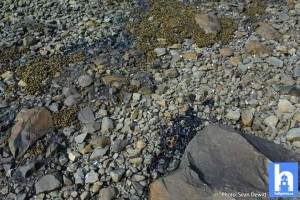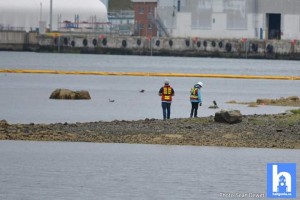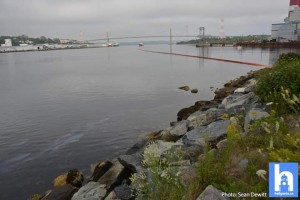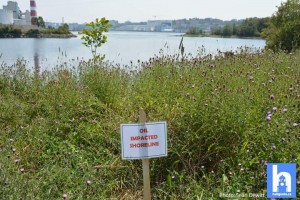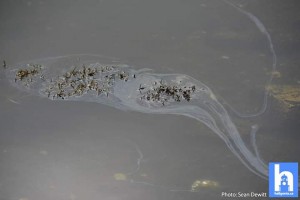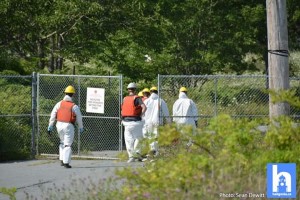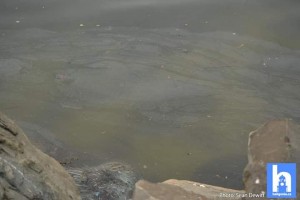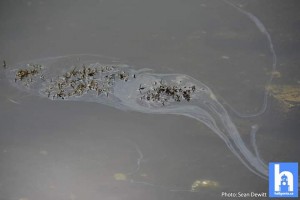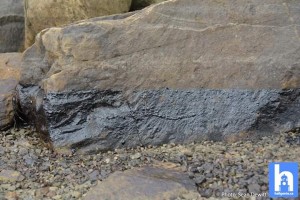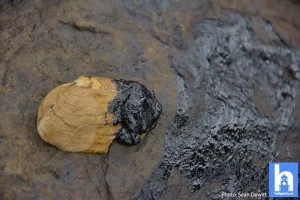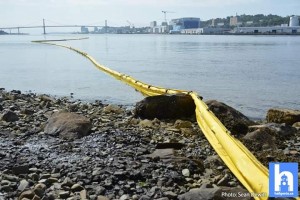CURRENT STATUS
The Tufts Cove oil clean-up is now complete. Environment and Climate Change Canada and Nova Scotia Environment have both inspected the site and confirmed the shoreline clean-up meets the requirements of the approved Shoreline Treatment Plan.
The final phase of work involved replacing appr. 150 metres of large rock boulders directly in front of the plant.
These boulders were installed in the 1990’s to maintain the structural integrity of underground infrastructure and as an artificial barrier to protect our property from water erosion.
The oil leak was caused by a small section of pipe that failed due to corrosion. The corrosion had thinned the pipe wall, which was under pipe insulation.
Since the leak, we have removed all pipe insulation and inspected every square inch of piping on our property to ensure it is in good condition.
We take full responsibility for this unfortunate incident.
We take our environmental commitments very seriously and we will apply what we have learned throughout the clean-up and subsequent investigation across our business to minimize the risk of something like this happening again.
KEY MILESTONES
Thursday, Aug. 2, 2018
- Tufts Cove staff discovered oil leak, Environmental Response Plan was activated:
- booms deployed in Halifax Harbour to contain the oil;
- ECRC (Eastern Canada Response Corporation), environmental services contractor and a certified marine response organization, arrived on-site;
- notification to the federal Environmental Emergencies 1-800 line and the Nova Scotia Emergency Management Office.
- Provided public statement and social media update.
Friday, Aug. 3, 2018
- Nova Scotia Environment (NSE) and Environment and Climate Change Canada (ECCC), visited Tufts Cove to review the oil leak and containment.
- Written report of the incident to NSE that less than 5,000 litres of oil was estimated to have released off the plant site into Halifax Harbour based on visual assessments from land and air.
- ECRC deployed oil absorbent materials called “pom poms” and “socks”, and noisemakers were initiated along the shoreline to deter birds and mammals away from site.
- Internal team assigned to initiate a comprehensive root cause investigation.
- Provided public statement and social media update.
Weekend of Aug. 4 – 6, 2018
- More than 80 Nova Scotia Power and contractor personnel worked on emergency response effort to recover oil from Halifax Harbour.
- ECRC drafted Shoreline Clean-up and Assessment Technique for oil recovery and treatment.
Thursday, Aug. 9, 2018
- ECCC convened Science Table. Representatives include NSE, ECCC (Environmental Emergencies & Canadian Wildlife Service), DFO, Indigenous and Northern Affairs Canada (INAC), and Millbrook First Nation.
Friday, Aug. 10, 2018
- Submitted official written notification to NSE of the oil release into Halifax Harbour, in compliance with the Contaminated Sites Regulations.
Tuesday, Aug. 14, 2018
- Notified Science Table and NSE of oil leak volume estimates and recovery status for Halifax Harbour (95% of less than 5,000 litres), the containment trench (95% of 9,900 litres), and the Unit 1 cooling water system (50% of 9,400 litres).
- Provided public statement and social media update.
Friday, Aug. 17, 2018
- Science Table provided confirmation of acceptance of proposed end-points for cleanup outlined in Shoreline Clean-up and Assessment Technique and Shoreline Treatment Plan.
Thursday, Aug. 30 to early December, 2018
- Clean-up efforts focused on the detailed clean-up directly in front of the plant, which was the most impacted. The final phase of work involved replacing approximately 150 metres of large rock boulders – called rip rap – where the remaining oil was located
.
Source : Release / Nova Scotia Power
Root Cause of Oil Leak Deemed “Confidential” by Nova Scotia Power
Nova Scotia Power (NSP) released an update on the Tufts Cove Oil Spill, a leak discovered in early August which resulted in over 24,000 litres being released of which at least 5,000 litres entered Halifax Harbour.
The update shared good news, that oil clean-up is now complete and has met the approval of Environment and Climate Change Canada and Nova Scotia Environment. The update included a timeline of events.
But the root cause of the corrosion that led to the leak remains unclear – at least for members of the public.
Yesterday, at 4:00 p.m., NSP emailed the Ecology Action Centre to say they are still completing the root cause investigation report, “but it will remain confidential.”
NSP went on to say that root cause analysis reports are not typically released to the public due to “confidential contents.”
Mark Butler, Policy Director at the EAC says concerned citizens have a right to know what caused the release of 24,000 litres of oil. “In our view there is a great deal more information that could be released to the public without jeopardizing the confidentiality of the operations of the company,” Butler says.
Butler applauds Nova Scotia Power for doing a thorough clean-up, including the removal of large boulders in front of the Generating Station. “We also welcome the news that Nova Scotia Power has inspected all their pipes and replaced the insulation covering the pipes,” Butler says.
However, Nova Scotians remain in the dark when it comes to the root cause, and public cost, of this spill.
The EAC has the following questions:
Prior to the spill when were the pipes last inspected? Corrosion under insulation is not a new problem.
Were other damaged pipes detected since the spill?
Why did it take so long to detect the spill which apparently was only detected by chance?
What was the overall impact on wildlife and marine habitat?
Was there any damage to the cooling system?
Is Environment and Climate Change Canada or Nova Scotia Environment going to prosecute Nova Scotia Power for the spill?
Will any federal or provincial agency be providing more information to the public?
Is Nova Scotia Power reconsidering its use of fuel oil at the facility?
What was the cost of the cleanup and what will the cost be to ratepayers? Will cleanup costs or insurance premium implications be put on the rate base or come from company profit?
The EAC says that If the company is not willing to reconsider releasing the root cause analysis, they plan to ask the Provincial or Federal Government to provide more information.
“We look forward to answers from Nova Scotia Power and federal and provincial agencies involved in the cleanup,” Butler says.
.
Source : Release / The Ecology Action Centre




